Nanostructured Mn–Ni Powders Produced by High-Energy Ball-Milling for Water Decontamination from RB5 Dye
Abstract
1. Introduction
2. Materials and Methods
3. Results
4. Conclusions
Author Contributions
Funding
Institutional Review Board Statement
Informed Consent Statement
Data Availability Statement
Conflicts of Interest
References
- Amin, N.K. Removal of direct blue-106 dye from aqueous solution using new activated carbons developed from pomegranate peel: Adsorption equilibrium and kinetics. J. Hazard. Mater. 2009, 165, 52–62. [Google Scholar] [CrossRef]
- Yahagi, T.; Degawa, M.; Seino, Y.; Matsushima, T.; Nagao, M.; Sugimura, T.; Hashimoto, Y. Mutagenicity of carcinogenic azo dyes and their derivatives. Cancer Lett. 1975, 1, 91–96. [Google Scholar] [CrossRef] [PubMed]
- Saratale, R.G.; Saratale, G.D.; Chang, J.S.; Govindwar, S.P. Bacterial decolorization and degradation of azo dyes: A review. J. Taiwan Inst. Chem. Eng. 2011, 42, 138–157. [Google Scholar] [CrossRef]
- Çatalkaya, E.Ç.; Bali, U.; Şengül, F. Photochemical degradation and mineralization of 4-chlorophenol. Environ. Sci. Pollut. Res. 2003, 10, 113–120. [Google Scholar] [CrossRef] [PubMed]
- Fu, W.; Yang, H.; Chang, L.; Hari-Bala; Li, M.; Zou, G. Anatase TiO2 nanolayer coating on strontium ferrite nanoparticles for magnetic photocatalyst. Colloids Surf. A Physico-Chem. Eng. Asp. 2006, 289, 47–52. [Google Scholar] [CrossRef]
- Asghar, A.; Raman, A.A.A.; Daud, W.M.A.W. Advanced oxidation processes for in-situ production of hydrogen peroxide/hydroxyl radical for textile wastewater treatment: A review. J. Clean. Prod. 2015, 87, 826–838. [Google Scholar] [CrossRef]
- Khan, T.A.; Dahiya, S.; Ali, I. Use of kaolinite as adsorbent: Equilibrium, dynamics and thermodynamic studies on the adsorption of Rhodamine B from aqueous solution. Appl. Clay Sci. 2012, 69, 58–66. [Google Scholar] [CrossRef]
- Tseng, W.J.; Lin, R.D. BiFeO3/α-Fe2O3 core/shell composite particles for fast and selective removal of methyl orange dye in water. J. Colloid Interface Sci. 2014, 428, 95–100. [Google Scholar] [CrossRef]
- Qin, X.D.; Zhu, Z.W.; Liu, G.; Fu, H.M.; Zhang, H.W.; Wang, A.M.; Li, H.; Zhang, H.F. Ultrafast degradation of azo dyes catalyzed by cobalt-based metallic glass. Sci. Rep. 2016, 5, 18226. [Google Scholar] [CrossRef]
- Chen, S.S.; Hsu, H.D.; Li, C.W. A new method to produce nanoscale iron for nitrate removal. J. Nanopart. Res. 2004, 6, 639–647. [Google Scholar] [CrossRef]
- Fan, J.; Guo, Y.H.; Wang, J.J.; Fan, M.H. Rapid Decolorization of azo Dye Methyl Orange in Aqueous Solution by Nanoscale zerovalent Iron Particles. J. Hazard. Mater. 2009, 166, 904–910. [Google Scholar] [CrossRef]
- Kumar, M.; Chakraborty, S. Chemical denitrification of water by zero-valent magnesium powder. J. Hazard. Mater. 2006, 135, 112–121. [Google Scholar] [CrossRef]
- Noubactep, C. Elemental metals for environmental remediation: Learning from cementation process. J. Hazard. Mater. 2010, 181, 1170–1174. [Google Scholar] [CrossRef]
- Kanel, S.R.; Manning, B.; Charlet, L.; Choi, H. Removal of arsenic(III) from groundwater by nanoscale zero-valent iron. Environ. Sci. Technol. 2005, 39, 1291–1298. [Google Scholar] [CrossRef]
- Schrick, B.; Blough, J.L.; Jones, A.D.; Mallouk, T.E. Hydrodechlorination of trichloroethylene to hydrocarbons using bimetallic nickel-iron nanoparticles. Chem. Mater. 2002, 14, 5140–5147. [Google Scholar] [CrossRef]
- Chang, J.H.; Cheng, S.F. The remediation performance of a specific electrokinetics integrated with zero-valent metals for perchloroethylene contaminated soils. J. Hazard. Mater. 2006, 131, 153–162. [Google Scholar] [CrossRef] [PubMed]
- Xiong, Z.; Zhao, D.; Pan, G. Rapid and complete destruction of perchlorate in water and ion-exchange brine using stabilized zero-valent iron nanoparticles. Water Res. 2007, 41, 3497–3505. [Google Scholar] [CrossRef] [PubMed]
- Hu, J.; Lo, I.M.C.; Chen, G. Fast removal and recovery of Cr(VI) using surface-modified jacobsite (MnFe2O4) nanoparticles. Langmuir 2005, 21, 11173–11179. [Google Scholar] [CrossRef]
- Dutta, A.K.; Maji, S.K.; Adhikary, B. γ-Fe2O3 Nanoparticles: An Easily Recoverable Effective Photo-Catalyst for the Degradation of Rose Bengal and Methylene Blue Dyes in the Waste-Water Treatment Plant. Mater. Res. Bull. 2014, 49, 28–34. [Google Scholar] [CrossRef]
- Huang, Y.; Fan, W.; Long, B.; Li, H.; Zhao, F.; Liu, Z.; Tong, Y.; Ji, H. Visible Light Bi2S3/Bi2O3/Bi2O2CO3 Photocatalyst for Effective Degradation of Organic Pollutions. Appl. Catal. B Environ. 2016, 185, 68–76. [Google Scholar] [CrossRef]
- Low, J.; Yu, J.; Jaroniec, M.; Wageh, S.; Al-Ghamdi, A.A. Heterojunction Photocatalysts. Adv. Mater. 2017, 29, 1601694. [Google Scholar] [CrossRef] [PubMed]
- Kurian, M.; Nair, D.S. Heterogeneous Fenton Behavior of Nano Nickel Zinc Ferrite Catalysts in the Degradation of 4-Chlorophenol from Water under Neutral Conditions. J. Water Process Eng. 2015, 8, e37–e49. [Google Scholar] [CrossRef]
- Ma, H.; Wang, H.; Na, C. Microwave-Assisted Optimization of Platinum-Nickel Nanoalloys for Catalytic Water Treatment. Appl. Catal. B Environ. 2015, 163, 198–204. [Google Scholar] [CrossRef]
- Chaturvedi, S.; Dave, P.N.; Shah, N.K. Applications of Nano-Catalyst in New Era. J. Saudi Chem. Soc. 2012, 16, 307–325. [Google Scholar] [CrossRef]
- Lin, S.T.; Thirumavalavan, M.; Jiang, T.Y.; Lee, J.F. Synthesis of ZnO/Zn Nano Photocatalyst Using Modified Polysaccharides for Photodegradation of Dyes. Carbohydr. Polym. 2014, 105, 1–9. [Google Scholar] [CrossRef]
- Adeleye, A.S.; Conway, J.R.; Garner, K.; Huang, Y.; Su, Y.; Keller, A.A. Engineered Nanomaterials for Water Treatment and Remediation: Costs, Benefits, and Applicability. Chem. Eng. J. 2016, 286, 640–662. [Google Scholar] [CrossRef]
- Anjum, M.; Miandad, R.; Waqas, M.; Gehany, F.; Barakat, M.A. Remediation of Wastewater Using Various Nano-Materials. Arab. J. Chem. 2019, 12, 4897–4919. [Google Scholar] [CrossRef]
- Akhavan, O. Lasting Antibacterial Activities of Ag-TiO2/Ag/a-TiO2 Nanocomposite Thin Film Photocatalysts under Solar Light Irradiation. J. Colloid Interface Sci. 2009, 336, 117–124. [Google Scholar] [CrossRef]
- Mbarek, W.; Saurina, J.; Escoda, L.; Pineda, E.; Khitouni, M.; Suñol, J.J. Effects of the Addition of Fe, Co on the Azo Dye Degradation Ability of Mn-Al Mechanically Alloyed Powders. Metals 2020, 10, 1578. [Google Scholar] [CrossRef]
- AboliGhasemabadi, M.; Mbarek, W.B.; Cerrillo-Gil, A.; Roca-Bisbe, H.; Casabella, O.; Blanquez, P.; Pineda, E.; Escoda, L.; Sunol, J.J. Azo-dye degradation by Mn–Al powders. J. Environ. Manag. 2020, 258, 110012. [Google Scholar] [CrossRef]
- Wang, J.Q.; Liu, Y.H.; Chen, M.W.; Xie, G.Q.; Louzguine-Luzgin, D.V.; Inoue, A.; Perepezko, J.H. Rapid Degradation of Azo Dye by Fe-Based Metallic Glass Powder. Adv. Funct. Mater. 2012, 22, 2567–2570. [Google Scholar] [CrossRef]
- Wang, J.Q.; Liu, Y.H.; Chen, M.W.; Louzguine-Luzgin, D.V.; Inoue, A.; Perepezko, J.H. Excellent capability in degrading azo dyes by MgZn-based metallic glass powders. Sci. Rep. 2012, 2, 418. [Google Scholar] [CrossRef] [PubMed]
- Sapkota, B.B.; Mishra, S.R. A Simple Ball Milling Method for the Preparation of p-CuO/n-ZnO Nanocomposite Photocatalysts with High Photocatalytic Activity. J. Nanosci. Nanotechnol. 2013, 13, 6588–6596. [Google Scholar] [CrossRef]
- Suryanarayana, C. Mechanical alloying and milling. Prog. Mater. Sci. 2001, 46, 1–184. [Google Scholar] [CrossRef]
- Ben Mbarek, W.; Azabou, M.; Pineda, E.; Fiol, N.; Escoda, L.; Sunol, J.J.; Khitouni, M. Rapid degradation of azo-dye using Mn–Al powders produced by ball-milling. RSC Adv. 2017, 7, 12620–12628. [Google Scholar] [CrossRef]
- Ben Mbarek, W.; Pineda, E.; Fiol, N.; Escoda, L.; Sunol, J.J.; Khitouni, M. High efficiency decolorization of azo dye Reactive Black 5 by Ca-Al particles. J. Environ. Chem. Eng. 2017, 5, 6107–6113. [Google Scholar] [CrossRef]
- Ghasemabadi, M.A.; Mbarek WBen Casabella, O.; Roca-Bisbe, H.; Pineda, E.; Escoda, L.; Sunol, J.J. Application of mechanically alloyed MnAl particles to de-colorization of azo dyes. J. Alloys Comp. 2018, 741, 240–245. [Google Scholar] [CrossRef]
- Kuyama, J.; Inui, H.; Imaoka, S.; Ishihara, K.N.; Shinhu, P. Nanometer-sized crystals formed by the mechanical alloying in the Ag-Fe system. Jpn. J. Appl. Phys. 1991, 30, L854. [Google Scholar] [CrossRef]
- Kuschke, W.M.; Keller, R.M.; Grahle, P.; Mason, R.; Arzt, E. Mechanisms of powder milling investigated by X-ray diffraction and quantitative metallography. Int. J. Mater. Res. 1995, 86, 804–813. [Google Scholar] [CrossRef]
- Mhadhbi, M.; Khitouni, M.; Azabou, M.; Kolsi, A. Characterization of Al and Fe nanosized powders synthesized by high energy mechanical milling. J. Mater. Charact. 2008, 59, 944–950. [Google Scholar] [CrossRef]
- El-Eskandarany, M.S. Mechanical Alloying for Fabrication of Advanced Engineering Materials; Noyes Publications/William Andrew Publishing: Norwich, NY, USA, 2001. [Google Scholar]
- Suryanarayana, C.; Koch, C.C. Non-Equilibrium Processing of Materials; Suryanarayana, C., Ed.; Pergamon: New York, NY, USA, 1999; pp. 313–344. [Google Scholar]
- Cao, J.; Wei, L.; Huang, Q.; Wang, L.; Han, S. Reducing degradation of azo dye by zero-valent iron in aqueous solution. Chemosphere 1999, 38, 565–571. [Google Scholar] [CrossRef]
- Nam, S.; Tratnyek, P.G. Reduction of azo dyes with zero-valent iron. Water Res. 2000, 34, 1837–1845. [Google Scholar] [CrossRef]
- Wu, F.; Deng, N.; Hua, H. Degradation mechanism of azo dye C. I. reactive red 2 by iron powder reduction and photooxidation in aqueous solutions. Chemosphere 2000, 4, 1233–1238. [Google Scholar] [CrossRef]
- Stylidi, M.; Kondarides, D.I.; Verykios, X.E. Pathways of solar light-induced photocatalytic degradation of azo dyes in aqueous TiO2 suspensions. Appl. Catal. B 2003, 40, 271–286. [Google Scholar] [CrossRef]
- Pauling, L. The nature of the interatomic forces in metals. Phys. Rev. 1938, 54, 899–904. [Google Scholar] [CrossRef]
- Pauling, L. A resonating-valence-bond theory of metals and intermetallic compounds. Proc. R. Soc. London. Ser. A Math. Phys. Sci. 1949, 196, 343–362. [Google Scholar] [CrossRef]
- Dowden, D.A. Heterogeneous catalysis. Part I. Theoretical basis. J. Chem. Soc. 1950, 56, 242–265. [Google Scholar] [CrossRef]
- Zhang CZhu ZZhang, H.; Sun, Q.; Liu, K. Effects of cobalt content on the decolorization properties of Fe-Si-B amorphous alloys. Results Phys. 2018, 10, 1–4. [Google Scholar] [CrossRef]
- Ponder, S.M.; Darab, J.G.; Mallouk, T.E. Remediation of Cr(VI) and Pb(II) aqueous solutions using supported, nanoscale zero-valent iron. Environ. Sci. Technol. 2000, 34, 2564–2569. [Google Scholar] [CrossRef]
- Deng, J.; Feng, S.; Ma, X.; Tan, C.; Wang, H.; Zhou, S.; Zhang, T.; Li, J. Heterogeneous degradation of Orange II with peroxymonosulfate activated by ordered mesoporous MnFe2O4. Separ. Purif. Technol. 2016, 167, 181–189. [Google Scholar] [CrossRef]
- Chen, J.X.; Zhu, L.Z. Heterogeneous UV-Fenton catalytic degradation of dyestuff in water with hydroxyl-Fe pillared bentonite. Catal. Today 2007, 126, 463–470. [Google Scholar] [CrossRef]
- Luo, X.K.; Li, R.; Huang, L.; Zhang, T. Nucleation and growth of nanoporous copper ligaments during electrochemical dealloying of Mg-based metallic glasses. Corros. Sci. 2013, 67, 100–108. [Google Scholar] [CrossRef]
- Yang, Y.Y.; Li, Z.L.; Wang, G.; Zhao, X.P.; Crowley, D.E.; Zhao, Y.H. Computational identification and analysis of the key biosorbent characteristics for the biosorption process of Reactive Black 5 onto fungal biomass. PLoS ONE 2012, 7, e33551. [Google Scholar] [CrossRef] [PubMed]
- Satapanajaru, T.; Chompuchan, C.; Suntornchot, P.; Pengthamkeerati, P. Enhancing Decolorization of Reactive Black 5 and Reactive Red 198 during Nano Zerovalent Iron Treatment. Desalination 2011, 266, 218–230. [Google Scholar] [CrossRef]
- Zhang, C.Q.; Zhu, Z.W.; Zhang, H.F.; Hu, Z.Q. Rapid decolorization of Acid Orange II aqueous solution by amorphous zero-valent iron. J. Environ. Sci. 2012, 24, 1021–1026. [Google Scholar] [CrossRef] [PubMed]
- Zhang, L.; Gao, X.; Zhang, Z.; Zhang, M.; Cheng, Y.; Su, J. A doping lattice of aluminum and copper with accelerated electron transfer process and enhanced reductive degradation performance. Sci. Rep. 2016, 6, 31797. [Google Scholar] [CrossRef]
- Mbarek, W.B.; Escoda, L.; Saurina, J.; Pineda, E.; Alminderej, F.M.; Khitouni, M.; Suñol, J.J. Nanomaterials as a Sustainable Choice for Treating Wastewater: A Review. Materials 2022, 15, 8576. [Google Scholar] [CrossRef]
- Méndez-Martínez, A.J.; Dávila-Jiménez, M.M.; Ornelas-Dávila, O.; Elizalde-González, M.P.; Arroyo-Abad, U.; Sirés, I.; Brillas, E. Electrochemical reduction and oxidation pathways for Reactive Black 5 dye using nickel electrodes in divided and undivided cells. Electrochim. Acta 2012, 59, 140–149. [Google Scholar] [CrossRef]
- Almeida, E.J.R.; Corso, C.R. Comparative study of toxicity of azo dye Procion Red MX-5B following biosorption and biodegradation treatments with the fungi Aspergillus niger and Aspergillus terreus. Chemosphere 2014, 112, 317–322. [Google Scholar] [CrossRef]
- Shilpa, S.; Shikha, R. Biodegradation of Dye Reactive Black-5 by a Novel Bacterial Endophyte. Int. Res. J. Environ. Sci. 2015, 4, 44–53. [Google Scholar]
- El Bouraie, M.; SalahEdin, W. Biodegradation of Reactive Black 5 by Aeromonas hydrophila strain isolated from dye contaminated textile wastewater. Sustain. Environ. Res. 2016, 26, 209–216. [Google Scholar] [CrossRef]
- Elías, V.R.; Sabre, E.V.; Winkler, E.L.; Satuf, M.L.; Rodriguez-Castellón, E.; Casuscelli, S.G.; Eimer, G.A. Chromium and titanium/chromium-containing MCM-41 mesoporous silicates as promising catalysts for the photobleaching of azo dyes in aqueous suspensions. A multitechnique investigation. Microporous Mesoporous Mater. 2012, 163, 85–95. [Google Scholar] [CrossRef]
- Ben Mbarek, W.; Daza, J.; Escoda, L.; Fiol, N.; Pineda, P.; Khitouni, M.; Suñol, J.J. Removal of Reactive Black 5 Azo Dye from Aqueous Solutions by a Combination of Reduction and Natural Adsorbents Processes. Metals 2023, 13, 474. [Google Scholar] [CrossRef]

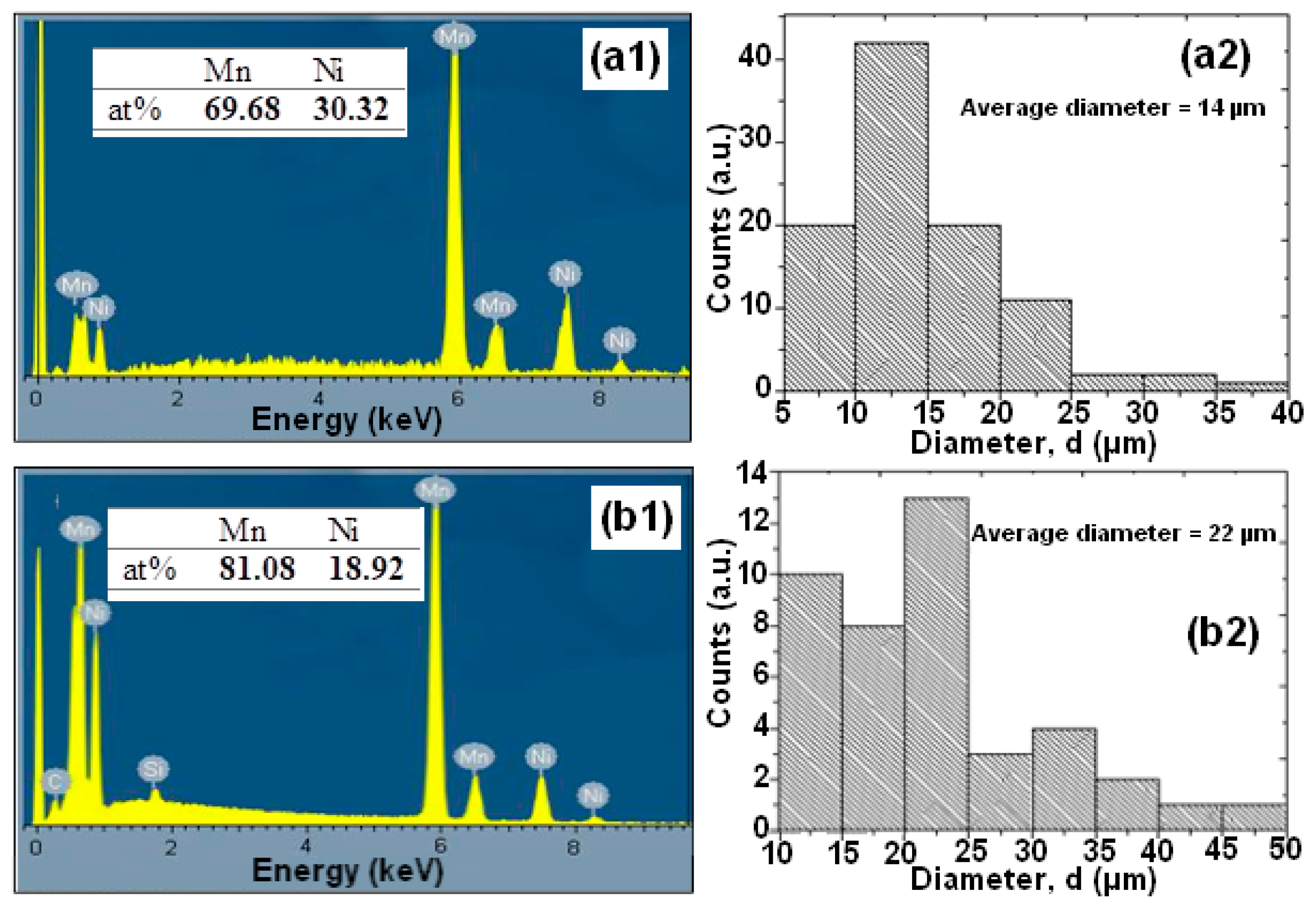
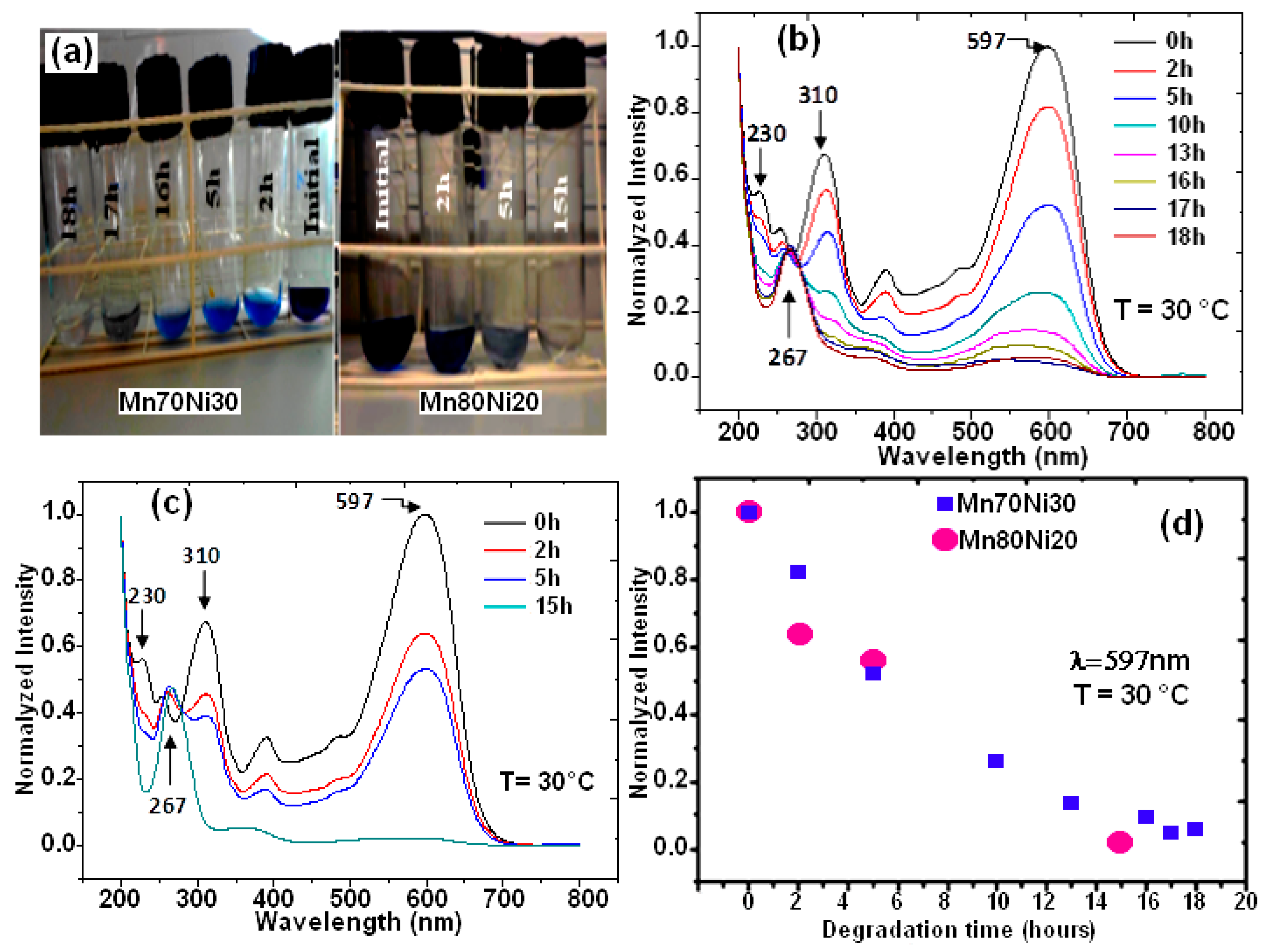


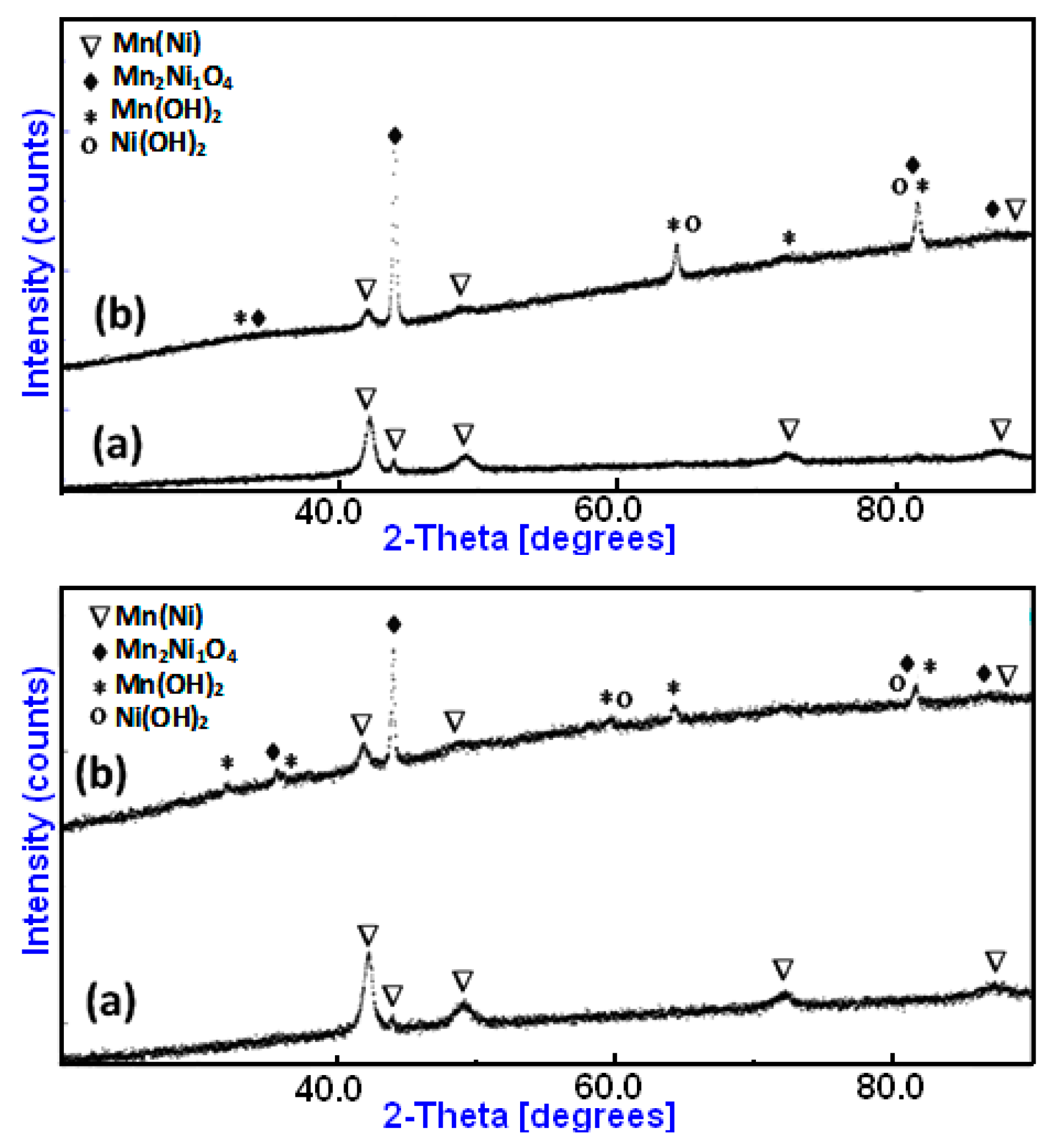
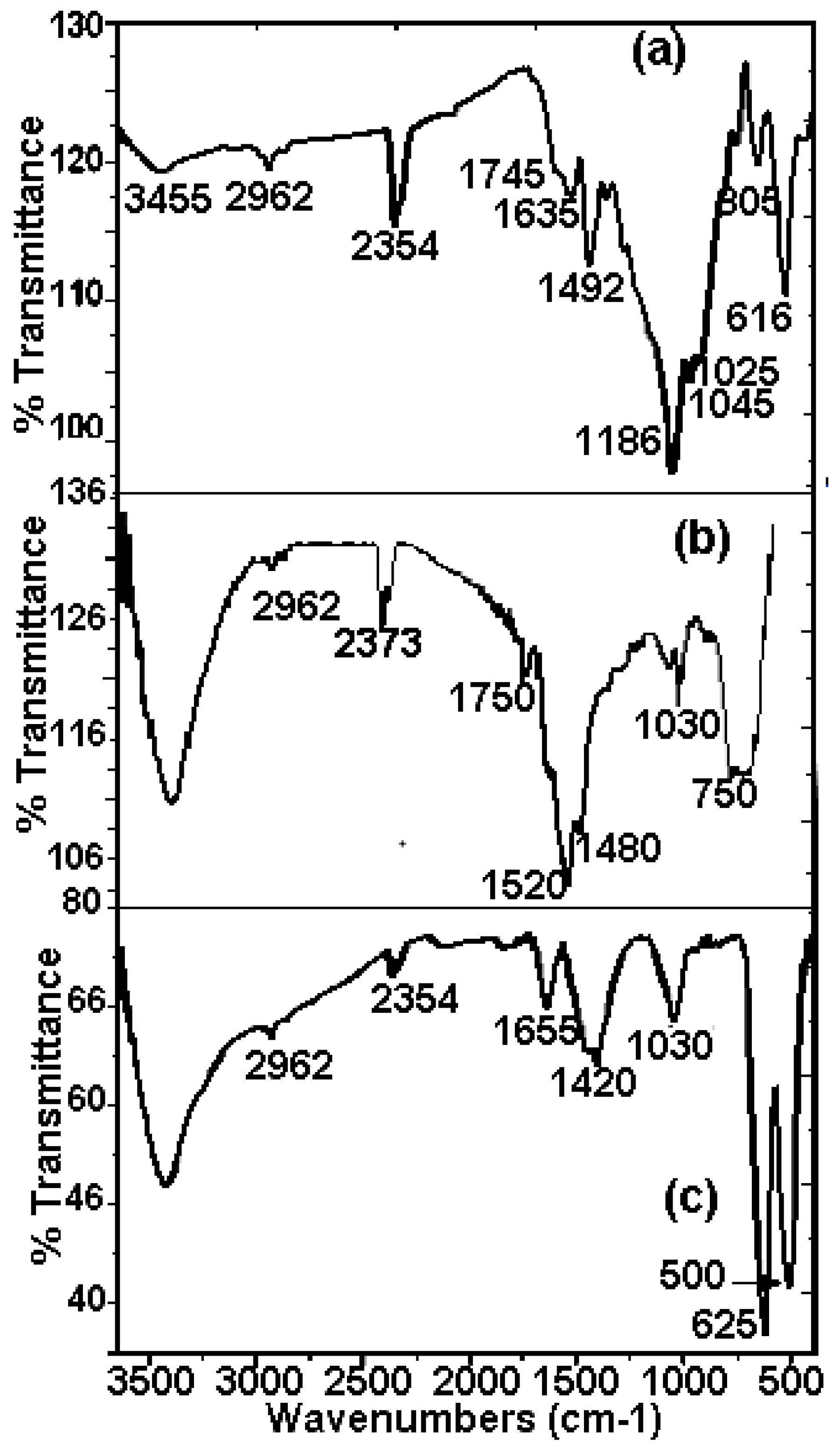
| The Mechanism in Acid or Neutral Medium | Micropile |
|---|---|
| Mn→Mn2+ + 2e− H2O→H3O+ + OH− 2H3O+ + 2e−→H2 + 2H2O Mn2+ + 2OH−→Mn(OH)2↓ R–N = N–R’ + H2→R–NH–NH–R’ R –NH–NH–R’ + H2→R–NH2 + R’–NH2 | 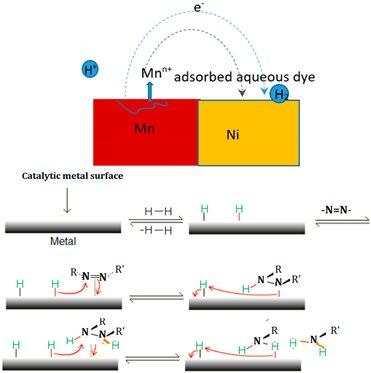 |
Reactive Black 5 Molecule (M.W.: 991) | |
|---|---|
| Peak/Band | Identification |
| 3411 cm−1 | O–H stretching vibration |
| 2936 cm−1 | Benzene ring skeletal vibration |
| 2354 cm−1 | C–H aldehyde vibration |
| 1745 cm−1 | C = C stretching vibration |
| 1635 cm−1 | azo bond (–N = N–) |
| 1528 cm−1 | N–H stretching vibration |
| 1492 cm−1 | C = C aromatic skeletal vibrations |
| 1260 cm−1 | C–N stretching vibration |
| 1186 cm−1 | C–OH stretching vibration |
| 1045 cm−1 | C–OH stretching vibration |
| 1028 cm−1 | Benzene mode coupling with stretching vibration of –SO3 |
| 804 cm−1 | –CH3 skeletal vibration |
| 616 cm−1 | Sulfonic group |
| Alloy Name | Route of Synthesis | RB5 Concentration | Alloy Dose | Time | Removal | Ref. |
|---|---|---|---|---|---|---|
| Zero-valent iron powder | Commercial | 100 mg/L | 0.5g/L | 120 min | 100% | [56] |
| Mn–Al | Ball-milled | 40 mg/L | 2.5 g/L | 20 min | 100% | [35] |
| Ca–Al | Ball-milled | 40 mg/L | 1g/L | 1 min | 100% | [36] |
| FeSiB | Ball-milled | 40mg/L | 2.5 g/L | 3 min | 100% | [65] |
| MnAlFe | Ball-milled | 40mg/L | 2.5 g/L | 5 min | 100% | [29] |
| MnAlCo | Ball-milled | 40mg/L | 2.5 g/L | 3 min | 100% | [29] |
| Mn-30%Ni | Ball-milled | 40mg/L | 2.5 g/L | 17 h | 100% | [Present work] |
| Mn-20%Ni | Ball-milled | 40mg/L | 2.5 g/L | 15 h | 100% | [Present work] |
Disclaimer/Publisher’s Note: The statements, opinions and data contained in all publications are solely those of the individual author(s) and contributor(s) and not of MDPI and/or the editor(s). MDPI and/or the editor(s) disclaim responsibility for any injury to people or property resulting from any ideas, methods, instructions or products referred to in the content. |
© 2023 by the authors. Licensee MDPI, Basel, Switzerland. This article is an open access article distributed under the terms and conditions of the Creative Commons Attribution (CC BY) license (https://creativecommons.org/licenses/by/4.0/).
Share and Cite
Mbarek, W.B.; Al Harbi, M.; Hammami, B.; Khitouni, M.; Escoda, L.; Suñol, J.-J. Nanostructured Mn–Ni Powders Produced by High-Energy Ball-Milling for Water Decontamination from RB5 Dye. Crystals 2023, 13, 879. https://doi.org/10.3390/cryst13060879
Mbarek WB, Al Harbi M, Hammami B, Khitouni M, Escoda L, Suñol J-J. Nanostructured Mn–Ni Powders Produced by High-Energy Ball-Milling for Water Decontamination from RB5 Dye. Crystals. 2023; 13(6):879. https://doi.org/10.3390/cryst13060879
Chicago/Turabian StyleMbarek, Wael Ben, Mohammed Al Harbi, Bechir Hammami, Mohamed Khitouni, Luisa Escoda, and Joan-Josep Suñol. 2023. "Nanostructured Mn–Ni Powders Produced by High-Energy Ball-Milling for Water Decontamination from RB5 Dye" Crystals 13, no. 6: 879. https://doi.org/10.3390/cryst13060879
APA StyleMbarek, W. B., Al Harbi, M., Hammami, B., Khitouni, M., Escoda, L., & Suñol, J.-J. (2023). Nanostructured Mn–Ni Powders Produced by High-Energy Ball-Milling for Water Decontamination from RB5 Dye. Crystals, 13(6), 879. https://doi.org/10.3390/cryst13060879









